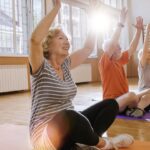Now Reading: How Exercise Aids Addiction Recovery: Moving Toward Sobriety
-
01
How Exercise Aids Addiction Recovery: Moving Toward Sobriety
How Exercise Aids Addiction Recovery: Moving Toward Sobriety

Addiction recovery is a deeply personal journey that requires mental, emotional, and physical resilience. While traditional therapies and support groups are essential, adding regular physical activity to your recovery routine can create powerful changes. This article explores how exercise aids addiction recovery by helping reduce cravings, lift mood, and build lasting routines that support sobriety.
Understanding Addiction Recovery
Addiction affects the brain’s reward system, especially neurotransmitters like dopamine and serotonin. These chemicals are responsible for feelings of pleasure and well-being. During active addiction, the brain becomes dependent on substances to trigger these chemical responses. In recovery, the brain must relearn how to function without these substances. That’s where exercise plays a key role.
How Exercise Aids Addiction Recovery
Let’s break down the science and benefits of movement in the recovery process. Whether it’s walking, yoga, weight training, or dancing—moving your body can become one of your most trusted recovery tools.
1. Reduces Cravings and Triggers
Cravings are one of the most difficult challenges in recovery. Physical activity helps decrease the intensity and frequency of these urges.
According to a 2014 study published in Frontiers in Psychiatry, aerobic exercise can reduce substance use and related cravings across various types of addictions, including alcohol, nicotine, and opioids [1]. When you engage in exercise, your brain releases dopamine—the same “feel good” chemical triggered by substances—but in a healthy, sustainable way.
2. Boosts Mood and Relieves Stress
Many people begin using substances to cope with stress, anxiety, or depression. Regular movement helps regulate these emotions.
Exercise increases endorphin levels—natural chemicals that boost mood and reduce pain. It also lowers cortisol, the stress hormone. This can lead to improved sleep, reduced anxiety, and a stronger emotional state, all of which are essential for a successful recovery.
A Harvard Medical School report highlights that just 15 minutes of running or one hour of walking daily can reduce the risk of major depression by 26% [2].
3. Creates Routine and Structure
Addiction often thrives in chaos and unpredictability. Recovery, on the other hand, benefits from routine and stability. Committing to a regular workout schedule brings structure to your day. This structure creates a healthy habit loop that can replace the destructive patterns of substance use.
Setting small fitness goals, like walking every morning or attending a yoga class twice a week, helps build confidence and a sense of accomplishment.
4. Improves Brain Function and Focus
One of the hidden benefits of exercise is how it helps improve cognitive function. This is especially helpful for people in early recovery, who may feel foggy or unfocused due to post-acute withdrawal symptoms.
Research from the Journal of Substance Abuse Treatment found that exercise can improve cognitive flexibility, memory, and decision-making in people recovering from addiction [3]. These improvements make it easier to stay mindful, make healthy decisions, and avoid relapse.
5. Builds Self-Esteem and Connection
Many people in recovery struggle with guilt, shame, or low self-worth. Exercise offers a non-judgmental space to feel better in your body and mind.
Group fitness classes or team sports can also foster connection, which is a key element in recovery. Engaging in movement with others helps reduce loneliness and creates a sense of belonging—both vital for long-term sobriety.

Best Types of Exercise for Addiction Recovery
Not all workouts have to be intense. What matters most is choosing something you enjoy. Here are some recovery-friendly exercises:
Walking or Jogging
Low-impact and accessible, walking is perfect for reducing stress and improving mood. You can do it solo or with a friend.
Yoga and Mindful Movement
Yoga combines movement with deep breathing and meditation, which helps manage anxiety and teaches presence. It also improves flexibility and reduces physical tension built up from stress or trauma.
Strength Training
Lifting weights boosts confidence and strengthens the body. It’s also a great outlet for releasing pent-up energy or emotions.
Swimming
Swimming is gentle on the joints, and the rhythmic nature of laps has a calming, meditative effect.
Dance or Martial Arts
Expressive movement like dance or martial arts helps channel emotions, build discipline, and reconnect with your body in a joyful way.
Tips for Getting Started
If you’re new to exercise or just returning, start small. Recovery isn’t about perfection—it’s about progress.
- Start slow: A 10-minute walk is a great first step.
- Make it enjoyable: Choose something fun so it doesn’t feel like a chore.
- Be consistent: Even light daily movement adds up over time.
- Listen to your body: Rest when needed and celebrate small victories.
- Stay accountable: Consider tracking your workouts or inviting a friend to join you.
Final Thoughts
Understanding how exercise aids addiction recovery can open the door to a stronger, more balanced recovery journey. Through physical movement, you activate healing, reduce cravings, improve your mood, and create a healthy structure that supports long-term sobriety.
The path to recovery is not linear, but every step—especially those taken in motion—counts. So whether you take a walk, roll out a yoga mat, or lift a few weights, remember: each movement is a move toward healing.
References
- Wang, D., Wang, Y., Wang, Y., Li, R., & Zhou, C. (2014). Impact of Physical Exercise on Substance Use Disorders: A Meta-Analysis. Frontiers in Psychiatry. https://www.frontiersin.org/articles/10.3389/fpsyt.2014.00177/full
- Harvard Health Publishing (2018). Exercise is an all-natural treatment to fight depression. https://www.health.harvard.edu/mind-and-mood/exercise-is-an-all-natural-treatment-to-fight-depression
- Smith, P. J., Blumenthal, J. A., Hoffman, B. M., Cooper, H., Strauman, T. A., Welsh-Bohmer, K., & Browndyke, J. N. (2010). Aerobic Exercise and Neurocognitive Performance: A Meta-Analytic Review of Randomized Controlled Trials. Journal of Substance Abuse Treatment. https://www.sciencedirect.com/science/article/abs/pii/S0740547217304011
























